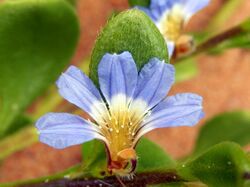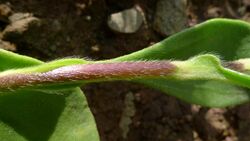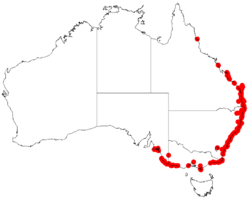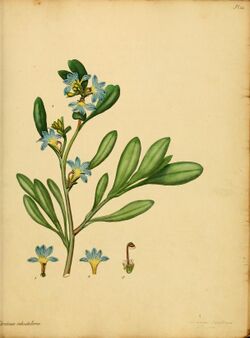Biology:Scaevola calendulacea
| Dune fan-flower | |
|---|---|

| |

| |
| Scientific classification | |
| Kingdom: | Plantae |
| Clade: | Tracheophytes |
| Clade: | Angiosperms |
| Clade: | Eudicots |
| Clade: | Asterids |
| Order: | Asterales |
| Family: | Goodeniaceae |
| Genus: | Scaevola |
| Species: | S. calendulacea
|
| Binomial name | |
| Scaevola calendulacea | |

| |
| Occurrence data from Australasian Virtual Herbarium | |
| Synonyms[3] | |
|
Goodenia calendulacea Andrews | |

Scaevola calendulacea commonly known as dune fan-flower,[5] is a flowering plant in the family Goodeniaceae. It is a small, mat-forming shrub with blue fan-shaped flowers with a yellow centre and grows on sand dunes in eastern and southern Australia.
Description
Scaevola calendulacea is a prostrate shrub growing to 40 cm high with oblong to lance shaped or egg shaped leaves up to 8 cm (3.1 in) long, 27 mm (1.1 in) wide, margins smooth with flattened hairs, and tapering to the base. The blue flowers are borne on terminal spikes up to 8 cm (3.1 in) long, corolla 12–18 mm (0.47–0.71 in) long, soft, short hairs on the outside, bearded inside and the wings are 1–2 mm (0.039–0.079 in) wide. Flowering occurs throughout the year and the fruit is white or purplish, globular, smooth, up to 12 mm (0.47 in) in diameter and the ovary has two locules.[5][6]
Taxonomy and naming
Scaevola calendulacea was first formally described in 1798 by Henry Cranke Andrews as Goodenia calendulacea,[4][7] but in 1917 was assigned to the genus, Scaevola, by George Claridge Druce.[2][7]The specific epithet (calendulacea) refers to the similarity to the genus Calendula.[8]
Distribution and habitat
This scaevola is a widespread species growing on sand dunes in coastal locations in South Australia, Queensland, New South Wales and Victoria.[5]
References
- ↑ "Scaevola calendulacea". Australian Plant Census. https://biodiversity.org.au/nsl/services/apc-format/display/91319.
- ↑ 2.0 2.1 Druce, G.C. (1917) Nomenclatorial Notes: chiefly African and Australian. The Botanical Exchange Club and Society of the British Isles Report for 1916, Suppl. 2: 644
- ↑ "Scaevola calendulacea (Andrews) Druce | Plants of the World Online | Kew Science". http://powo.science.kew.org/taxon/urn:lsid:ipni.org:names:384162-1.
- ↑ 4.0 4.1 Andrews, H.C. (1798) Repository for New, and Rare Plants 1: t. 22
- ↑ 5.0 5.1 5.2 Carolin, R.C. "Scaevola calendulacea". Royal Botanic Garden Sydney. https://plantnet.rbgsyd.nsw.gov.au/cgi-bin/NSWfl.pl?page=nswfl&lvl=sp&name=Scaevola~calendulacea.
- ↑ Carolin, R.C. (2017). "Scaevola calendulacea. In: Flora of Australia". Australian Biological Resources Study, Department of the Environment and Energy, Canberra. https://profiles.ala.org.au/opus/foa/profile/Scaevola+calendulacea.
- ↑ 7.0 7.1 "Scaevola calendulacea". Australian Plant Name Index (APNI), IBIS database. Centre for Plant Biodiversity Research, Australian Government. https://biodiversity.org.au/nsl/services/rest/name/apni/91319.
- ↑ Sharr, Francis Aubi; George, Alex (2019). Western Australian Plant Names and Their Meanings (3rd ed.). Kardinya, WA: Four Gables Press. p. 155. ISBN 9780958034180.
Wikidata ☰ Q17480616 entry
 |

